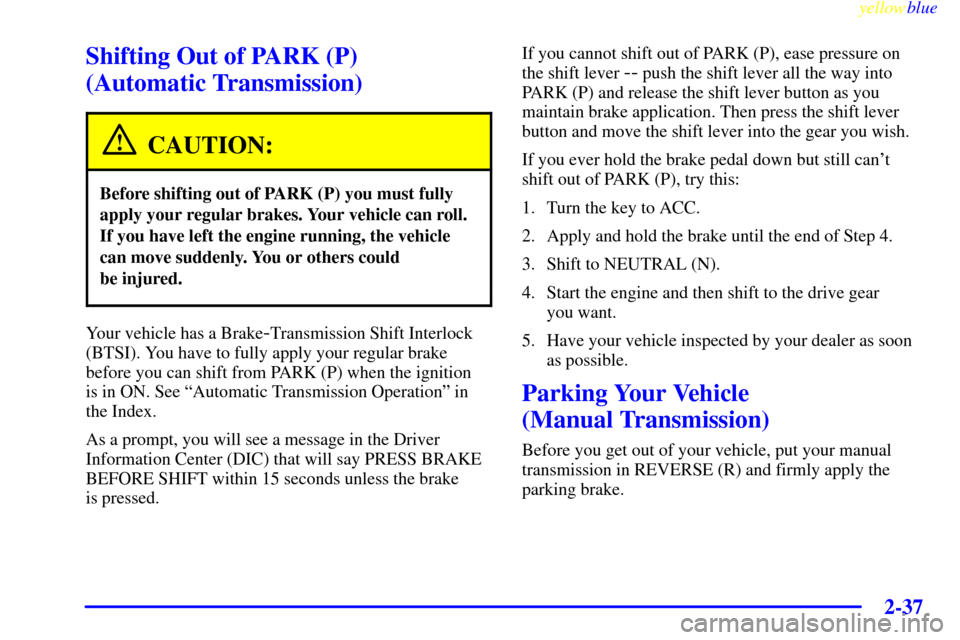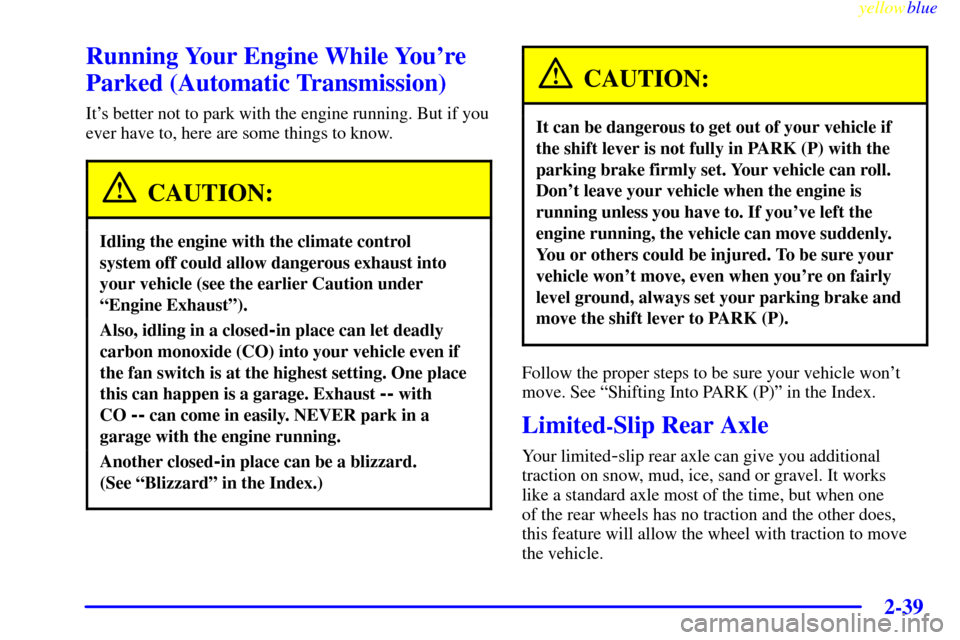Page 89 of 376

yellowblue
2-37
Shifting Out of PARK (P)
(Automatic Transmission)
CAUTION:
Before shifting out of PARK (P) you must fully
apply your regular brakes. Your vehicle can roll.
If you have left the engine running, the vehicle
can move suddenly. You or others could
be injured.
Your vehicle has a Brake-Transmission Shift Interlock
(BTSI). You have to fully apply your regular brake
before you can shift from PARK (P) when the ignition
is in ON. See ªAutomatic Transmission Operationº in
the Index.
As a prompt, you will see a message in the Driver
Information Center (DIC) that will say PRESS BRAKE
BEFORE SHIFT within 15 seconds unless the brake
is pressed.If you cannot shift out of PARK (P), ease pressure on
the shift lever
-- push the shift lever all the way into
PARK (P) and release the shift lever button as you
maintain brake application. Then press the shift lever
button and move the shift lever into the gear you wish.
If you ever hold the brake pedal down but still can't
shift out of PARK (P), try this:
1. Turn the key to ACC.
2. Apply and hold the brake until the end of Step 4.
3. Shift to NEUTRAL (N).
4. Start the engine and then shift to the drive gear
you want.
5. Have your vehicle inspected by your dealer as soon
as possible.
Parking Your Vehicle
(Manual Transmission)
Before you get out of your vehicle, put your manual
transmission in REVERSE (R) and firmly apply the
parking brake.
Page 91 of 376

yellowblue
2-39
Running Your Engine While You're
Parked (Automatic Transmission)
It's better not to park with the engine running. But if you
ever have to, here are some things to know.
CAUTION:
Idling the engine with the climate control
system off could allow dangerous exhaust into
your vehicle (see the earlier Caution under
ªEngine Exhaustº).
Also, idling in a closed-in place can let deadly
carbon monoxide (CO) into your vehicle even if
the fan switch is at the highest setting. One place
this can happen is a garage. Exhaust
-- with
CO
-- can come in easily. NEVER park in a
garage with the engine running.
Another closed-in place can be a blizzard.
(See ªBlizzardº in the Index.)
CAUTION:
It can be dangerous to get out of your vehicle if
the shift lever is not fully in PARK (P) with the
parking brake firmly set. Your vehicle can roll.
Don't leave your vehicle when the engine is
running unless you have to. If you've left the
engine running, the vehicle can move suddenly.
You or others could be injured. To be sure your
vehicle won't move, even when you're on fairly
level ground, always set your parking brake and
move the shift lever to PARK (P).
Follow the proper steps to be sure your vehicle won't
move. See ªShifting Into PARK (P)º in the Index.
Limited-Slip Rear Axle
Your limited-slip rear axle can give you additional
traction on snow, mud, ice, sand or gravel. It works
like a standard axle most of the time, but when one
of the rear wheels has no traction and the other does,
this feature will allow the wheel with traction to move
the vehicle.
Page 103 of 376

yellowblue
2-51
Exterior Lamps
Daytime Running Lamps / Automatic
Headlamp Control (Optional)
Daytime Running Lamps (DRL) can make it easier for
others to see the front of your vehicle during the day.
DRL can be helpful in many different driving
conditions, but they can be especially helpful in the
short periods after dawn and before sunset.
A light sensor on top of the instrument panel makes the
Automatic Headlamp Control (if equipped) work, so be
sure it isn't covered.
The DRL/Automatic Headlamp Control system will
make the front turn signal lamps come on when:
�the ignition is on,
�the headlamp switch is off and
�the parking brake is released.
When the DRL are on, only the front turn signal lamps
will be on. The headlamps, taillamps, sidemarker and
other lamps won't be on. Your instrument panel won't
be lit up either.When it's dark enough outside, the front turn signal
lamps will turn off and the headlamps and parking
lamps will turn on. The other lamps that come on with
the headlamps will also come on.
When it's bright enough outside, the headlamps will go
off and the front turn signal lamps will come on.
To idle the vehicle with the DRL off, set the parking
brake while the ignition is in OFF or LOCK. Then start
the vehicle. The DRL, headlamps and parking lamps
will stay off until you release the parking brake.
The Automatic Headlamp Control feature can be turned
on or off except for vehicles first sold in Canada. See
ªDriver Information Center (DIC)º in the Index to turn
this feature on or off (if equipped with the Automatic
Headlamp Control feature).
As with any vehicle, you should turn on the regular
headlamp system when you need it.
Page 114 of 376
yellowblue
2-62
NOTICE:
To avoid damage to the roof panel, paint and
weatherstripping, do not drop or rest it on its
edges. Place the roof panel in the egg
-shaped
stowage receivers after removing it from
the vehicle.
1. Park on a level surface, set the parking brake firmly
and shift an automatic transmission into PARK (P).
Shift a manual transmission into REVERSE (R).
Turn the ignition key to OFF. Lower both sunshades
and rotate them toward the door glass.
2. Open the rear liftgate and remove any items that may
interfere with proper storage of the roof panel.
Also install the two egg
-shaped stowage receivers
into the floor of the rear storage compartment.
Secure both receivers into their proper positions by
turning them counterclockwise.
3. Lower the windows and open the doors.
Page 121 of 376
yellowblue
2-69 Lowering the Convertible Top
NOTICE:
Don't leave the convertible out with the top down
for any long periods of time. The sun and rain
can damage the seat material and other things
inside the vehicle.
1. Set the parking brake firmly. Shift an automatic
transmission into PARK (P). Shift a manual
transmission into REVERSE (R). Turn the ignition
key to OFF. Lower both sunshades and rotate them
toward the door glass.
NOTICE:
Before lowering the convertible top into the
storage area, be sure there are no objects in the
way of the folded, stored top. The weight of a
stored top on items in the storage area may cause
the convertible top back glass to break.
2. Unlock the front of the convertible top by lowering
the latch handles and turning them inward. Push the
latch handles back to the up position.
Page 124 of 376
yellowblue
2-72
6. Then move the top rearward to its
fully
-stored position.
7. After the top is stored, apply one even push on the
center of the front edge (A) of the convertible top to
assure the top is fully retracted.
8. Close the storage compartment lid (C) by closing
with a swift, firm motion.
Raising the Convertible Top
1. Park on a level surface, set the parking brake firmly
and shift an automatic transmission into PARK (P).
Shift a manual transmission into REVERSE (R).
Lower both windows and sunshades and turn the
ignition key to OFF.
2. Tilt the driver's seat forward and press the storage
compartment release button, or use the manual
release cable if battery power has been lost. Lift the
storage compartment lid (C). (After pressing the
release button, the driver and passenger door glass
should retract to the full
-down position, if they have
not already been lowered.)
Page 127 of 376
yellowblue
2-75
The main components of your instrument panel are:
A. HUD Controls (Option)
B. Turn Signal/Multifunction Lever
C. Driver Information Center (DIC)
(Located in the Instrument Cluster)
D. Instrument Panel Cluster
E. Windshield Wiper/Washer Lever
F. Driver Information Center (DIC) Buttons
G. Hazard Warning Flasher Button
H. Center Air Vent
I. Audio System
J. Comfort Controls
K. Fog Lamp Button (Option)
L. Remote Hatch Release Button (Coupe) or Remote
Trunk Release Button (Convertible/Hardtop)M. Ignition Switch
N. Shift Lever (Automatic Shown)
O. Traction Control System (TCS) Switch/Active
Handling Switch (Option)
P. Accessory Power Outlet
(Located in the Center Console)
Q. Selective Real Time Damping (SRTD) (Option)
R. Instrument Panel Cupholder
S. Remote Fuel Door Release Button
(Located in the Center Console)
T. Ashtray and Cigarette Lighter
U. Parking Brake
V. Glove Box
W. Instrument Panel Fuse Block
Page 132 of 376

yellowblue
2-80
If it doesn't come on then, have it fixed so it will be
ready to warn you if there's a problem. If this warning
light stays on after you start the engine, the parking
brake may not be set or there could be a brake problem.
Refer to ªParking Brakeº in the Index to see if it is set.
If the parking brake is not set, have your brake system
inspected right away.
If the light comes on while you are driving and you have
a LOW BRAKE FLUID message showing on the DIC,
pull off the road and stop carefully. You may notice that
the pedal is harder to push. Or, the pedal may go closer
to the floor. It may take longer to stop. If the light is still
on, have the vehicle towed for service. (See ªTowing
Your Vehicleº in the Index.)
CAUTION:
Your brake system may not be working properly
if the brake warning light is on. Driving with the
brake warning light on can lead to an accident.
If the light is still on after you've pulled off the
road and stopped carefully, have the vehicle
towed for service.
Anti-Lock Brake System Warning Light
With the anti-lock brake
system, the light will come
on when you start your
engine and may stay on
for several seconds.
That's normal.
If the light stays on, turn the ignition to OFF. Or, if the
light comes on when you're driving, stop as soon as
possible and turn the ignition off. Then start the engine
again to reset the system. If the light still stays on, or
comes on again while you're driving, your vehicle needs
service. If the regular brake system warning light isn't
on, you still have brakes, but you don't have anti
-lock
brakes. If the regular brake system warning light is also
on, you don't have anti
-lock brakes and there's a
problem with your regular brakes. See ªBrake System
Warning Lightº earlier in this section.
The anti
-lock brake system warning light should come
on briefly when you turn the ignition key to ON. If the
light doesn't come on then, have it fixed so it will be
ready to warn you if there is a problem.